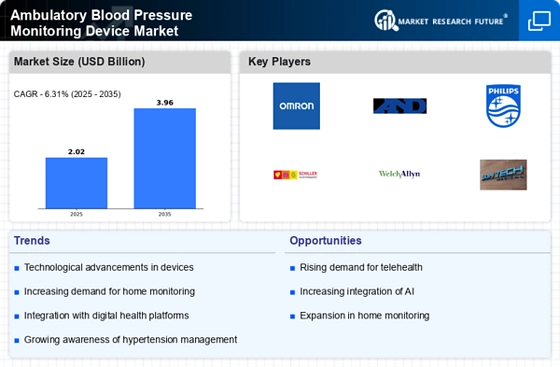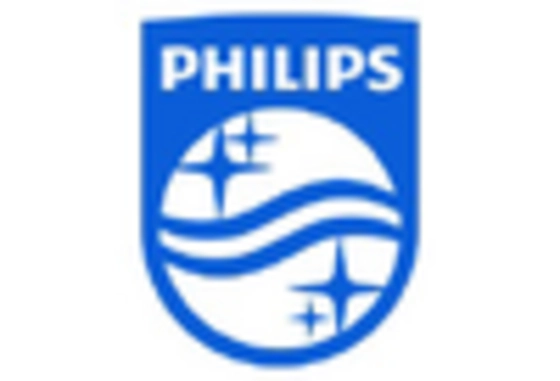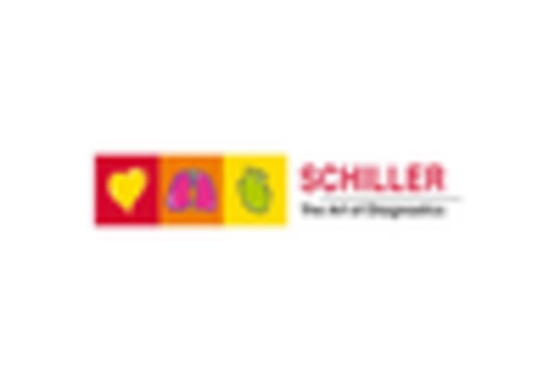Rising Prevalence of Hypertension
The Ambulatory Blood Pressure Monitoring Device Market is significantly influenced by the rising prevalence of hypertension worldwide. As lifestyle-related diseases become more common, the demand for effective monitoring solutions has escalated. Recent statistics indicate that nearly one in four adults suffers from hypertension, necessitating regular monitoring to manage the condition effectively. This growing patient population drives the need for ambulatory blood pressure monitors, which provide continuous and accurate readings. Furthermore, healthcare systems are increasingly recognizing the importance of early detection and management of hypertension, further propelling the Ambulatory Blood Pressure Monitoring Device Market. The emphasis on proactive healthcare measures suggests a sustained demand for these monitoring devices.
Patient-Centric Design and Usability
The Ambulatory Blood Pressure Monitoring Device Market is increasingly characterized by a shift towards patient-centric design and usability. Manufacturers are focusing on creating devices that are not only accurate but also user-friendly, ensuring that patients can easily operate them without extensive training. Features such as intuitive interfaces, lightweight designs, and mobile app connectivity are becoming standard. This focus on usability is crucial, as it enhances patient engagement and adherence to monitoring regimens. As the market evolves, the emphasis on patient-centric design is likely to play a pivotal role in shaping the Ambulatory Blood Pressure Monitoring Device Market, potentially leading to higher adoption rates and improved health outcomes.
Increased Focus on Preventive Healthcare
The Ambulatory Blood Pressure Monitoring Device Market is benefiting from a heightened focus on preventive healthcare measures. As healthcare systems shift towards value-based care, there is a growing recognition of the importance of early detection and management of chronic conditions such as hypertension. This trend encourages patients to engage in regular monitoring of their blood pressure, leading to increased demand for ambulatory devices. Moreover, healthcare providers are advocating for the use of these devices to reduce the long-term costs associated with untreated hypertension. The emphasis on preventive care is likely to drive innovation and investment in the Ambulatory Blood Pressure Monitoring Device Market, fostering a more proactive approach to health management.
Regulatory Support and Reimbursement Policies
The Ambulatory Blood Pressure Monitoring Device Market is positively impacted by supportive regulatory frameworks and favorable reimbursement policies. Governments and health organizations are increasingly recognizing the importance of ambulatory monitoring in managing hypertension and other cardiovascular diseases. This recognition has led to the establishment of guidelines that promote the use of these devices in clinical practice. Additionally, favorable reimbursement policies for ambulatory blood pressure monitoring are encouraging healthcare providers to adopt these technologies. As reimbursement becomes more accessible, the Ambulatory Blood Pressure Monitoring Device Market is likely to see increased investment and innovation, ultimately benefiting patients through improved access to essential monitoring tools.
Technological Advancements in Monitoring Devices
The Ambulatory Blood Pressure Monitoring Device Market is experiencing a surge in technological advancements that enhance the accuracy and usability of these devices. Innovations such as wireless connectivity, smartphone integration, and advanced algorithms for data analysis are becoming increasingly prevalent. These advancements not only improve patient compliance but also facilitate real-time monitoring, allowing healthcare providers to make timely decisions. According to recent data, the market for wearable health technology, which includes ambulatory blood pressure monitors, is projected to grow significantly, indicating a shift towards more sophisticated monitoring solutions. As technology continues to evolve, the Ambulatory Blood Pressure Monitoring Device Market is likely to benefit from increased adoption rates and improved patient outcomes.

















Leave a Comment